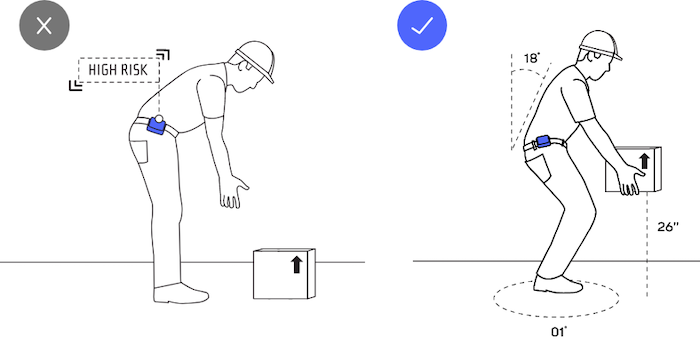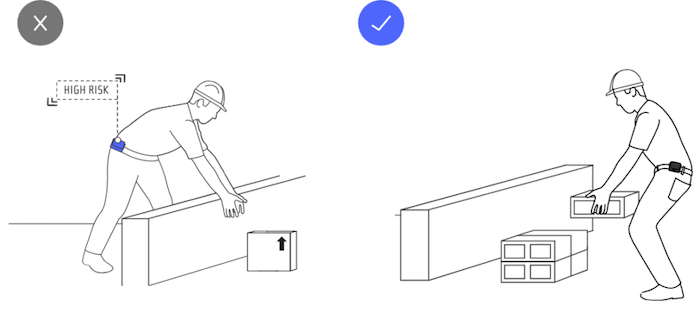High-risk postures remain one of the leading safety threats in today’s industrial workplace. Awkward movements commonly performed on the job – such as bending, overreaching, and twisting – stress employees’ musculoskeletal systems and lead to costly injuries over time.
Wearable devices can help reduce the number of these injuries by providing employees with real-time awareness of the movements they’re performing that can lead to injury. Many of these movements can be avoided altogether by using proper lifting techniques.
Here are a few of our top tips and techniques for helping employees reduce the number of high-risk movements they perform on the job:
Bending

- Face the object you are moving or picking up.
- Keep your back straight.
- Bend at the hips and knees together, lowering your body towards the ground.
- On the way up, push your feet into the ground and feel your legs and hips doing the work.
Overreaching

- If possible, move your body as close as possible to the object you’re lifting before you lift it.
- If you can’t move your body close, try to pull the item closer to you using a “pick stick” or while bending minimally at the waist. Then, continue with the proper technique once the object is as close to you as possible.
- If the above options aren’t possible, try “building a bridge” by placing one arm on the surface in front of you to help support your body and share the stress on your back.
Twisting

- Before lifting an object, make sure your toes are pointed towards it.
- If the object is to your side or behind you, pivot your feet so your toes and hips face the object.
- After your feet and hips face the object, safely lift it with good technique, as you would do while avoiding high-risk bending.
Avoidable vs. Unavoidable High-risk Postures
Not all high-risk postures performed by employees can be prevented by using proper lifting techniques. It’s important to understand what your team members can and can’t control, as well as how employers can help drive change too.
Avoidable High-risk Postures
A high-risk posture is considered avoidable if an employee has the proper space or equipment to safely move an object.
For example, if an employee is removing a box from a cart or pallet and transferring it to another surface, as long as they have the space around them to move properly, employees can make significant reductions in the avoidable high-risk postures they perform, as they become aware of them through real-time feedback.
Unavoidable High-risk Postures
A high-risk posture is considered unavoidable when an employee’s ability to perform a proper lifting technique is restricted by space or surrounding objects in the workplace.
For example, if an employee is removing a box from a cart or pallet and there is not sufficient space to reach it or get close to it, it becomes an unavoidable high-risk posture. This often happens with objects at the back of a pallet, or on the back of a shelf. Data from wearable tech can help employers identify opportunities to reduce these unavoidable high-risk postures by changing the setup of a workstation or using new equipment.
Using Wearables to Reduce High-risk Postures
Wearable technology can automatically recognize unsafe movements commonly performed on the job, and provide employees with continuous coaching. By alerting employees every time a high-risk posture is performed, wearables help create new habits and drive sustained behavior change over time.
Furthermore, wearable tech provides management with valuable new data and actionable insights to improve workplace ergonomics. As high-risk postures are consistently reduced, so are injuries. The end result is a safer, healthier, more productive workforce with fewer workers’ compensation claims and premium savings for policyholders.
